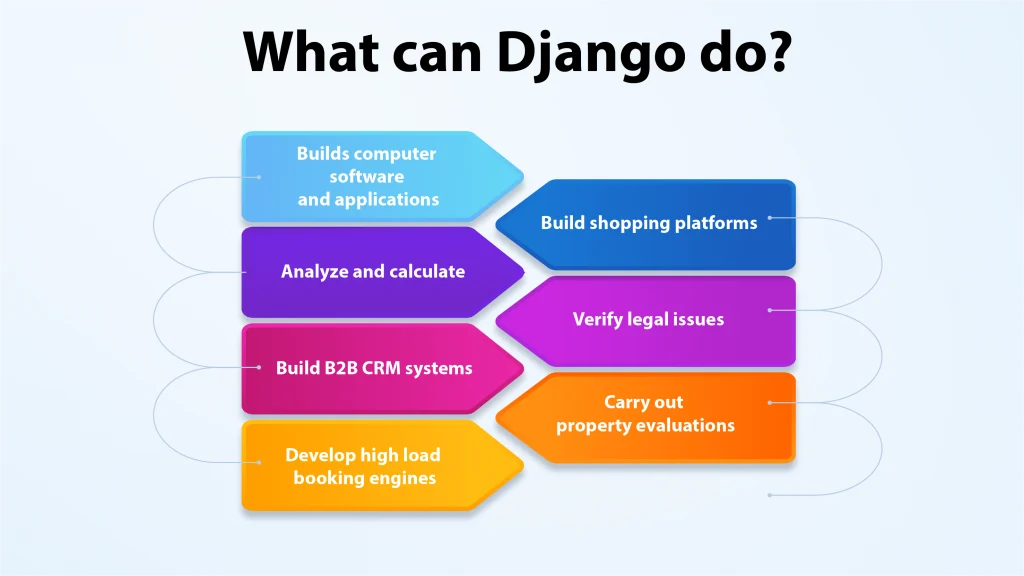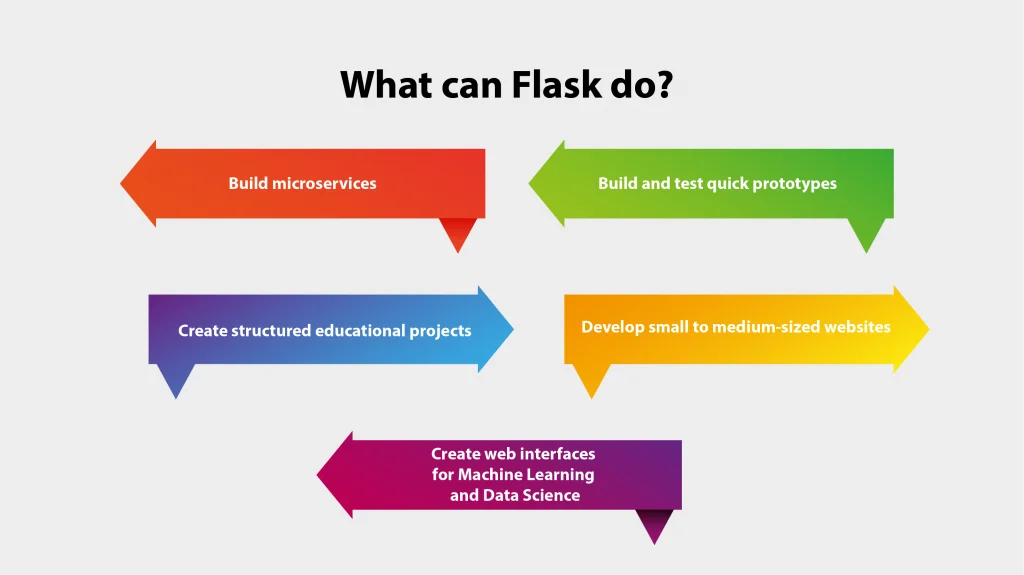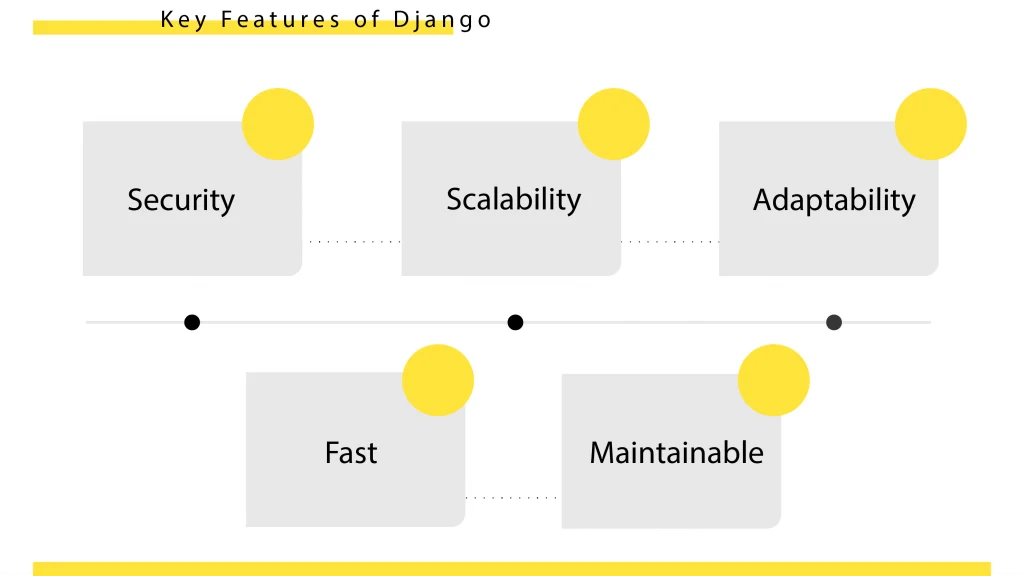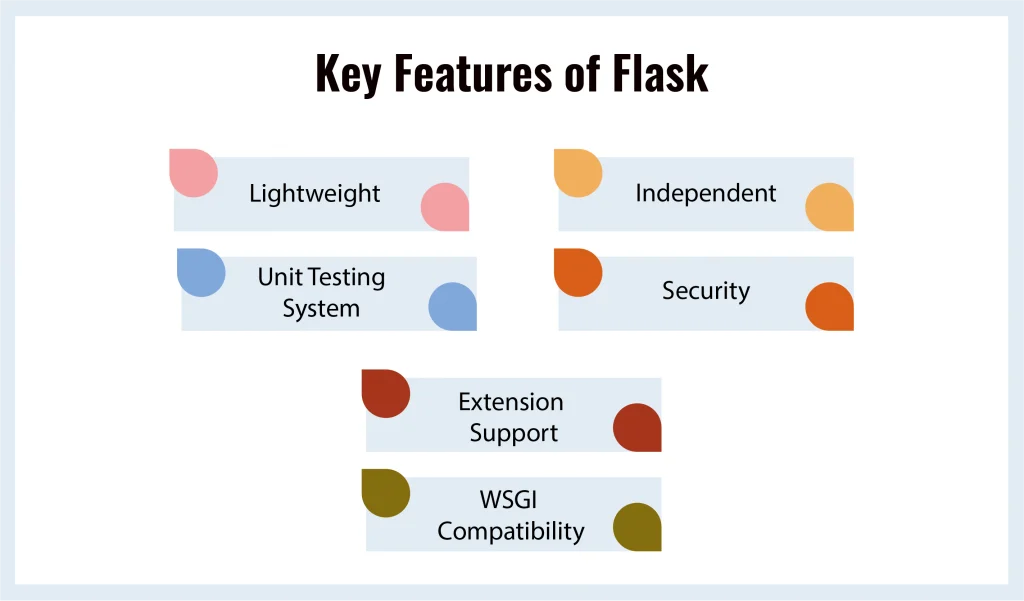Table of Contents
ToggleIntroduction
If you are a web developer who specializes in creating high-functioning web applications using Python, you may have often come across Django and Flask. Python web frameworks like Django and Flask offer built-in libraries, toolkits and a vast community support to help developers build quality processes and protocols for web applications. The Python Developers Survey 2022 reports that Django and Flask are the most popular Python web frameworks deployed by developers. This blog dives deeper into Django and Flask — what they are, their uses, and how they fare when compared to each other.
What is Django?
Django is a high-level Python Web application framework known for rapid development and clean design. It is widely used by software engineers and developers to build computer software and applications for Information Technology and Services. According to G2’s review of the best Python web frameworks, Django offers great built-in features, community support, and security focus among other things. With a rating of 4.5/5, G2 users have ranked it as the easiest Python web framework to use.
What can you do with Django?
Because of its simple syntax, Django is widely used in industries including publishing, e-commerce, retail, and finance. Here are a few practical uses of Django.

- Django is used by financial platforms to analyze and calculate results based on factors such as personal data and risk tolerance.
- You can use Django to build B2B CRM systems to handle communication between businesses.
- Django can be used to develop high load booking engines or shopping platforms.
- Legal enterprises use Django to handle legal issues like verifying mortgage conditions or lease status.
- Django is also used in the real estate industry to carry out property evaluations.
Must Read: Django vs React: Know the Difference
What is Flask?
Flask is a web application framework written in Python. It is a microframework based on the Werkzeug WSGI toolkit and the Jinja2 template engine. Like Django, software engineers use Flask to create computer software and applications for Information Technology and Services. With a rating of 4.5/5, G2 users have ranked Flask as the second easiest Python web framework to use after Django.
What can you do with Flask?
Like Django, Flask’s simplicity and flexibility makes it a great choice to develop web applications for e-commerce sites, social media platforms, and more. Here are a few applications of Flask.

- Flask is used to build microservices that have independently deployable constituents within extensive applications.
- You can use Flask to build and test quick prototypes for web-based ideas and concepts.
- Flask is used to build interactive dashboards with real-time data analysis.
- Developers use Flask to create structured educational projects that teach web development projects.
- Flask is used to build small to medium-sized websites that are lightweight but feature rich.
- You can create web interfaces for Machine Learning and Data Science models.
Key Features of Django

Security
Django’s robust authentication systems guarantee security against threats such as clickjacking, unauthorized access, and cyberattacks.
Scalability
Every layer in Django is independent. This allows developers to make changes in different layers without much cost, effort, and maintenance.
Adaptability to Heavy-Load Projects
Django can manage the traffic generated by content management systems and complex social networks. Further, Django can also ensure error-free results even if the core is complex.
Fast
Django has built-in tools and libraries to help developers create web applications from concept to completion as fast as possible.
Maintainable
Django uses the DRY (Don’t Repeat Yourself) principle to avoid unnecessary duplication of code. With Django, familiar functions can be grouped into reusable applications. Also, it helps group related code into modules.
Key Features of Flask

Lightweight
Flask is not dependent on external libraries which makes it easy for developers to use it even for complex web applications.
Independent
Flask gives developers the freedom and full control to experiment with its architecture and libraries while working on app development.
Unit Testing System
Flask has an integrated unit testing system that facilitates quicker debugging, robust development, and gives developers freedom to experiment while working on app development.
Security
Flask supports secure cookies, which ensures that there is no unauthorized access allowed.
Extension Support
You can use third-party extensions like Flask SQLAlchemy and WTForms for added functionality when working with Flask. The extensions allow support for databases and web forms.
WSGI Compatibility
Flask is based on the Werkzeug Web Server Gateway Interface (WSGI). This utility library makes Flask applications compatible with any WSGI-compliant web server.

Don't miss out on your chance to work with the best
apply for top global job opportunities today!
Django: Pros and Cons
| Pros | Cons |
|---|---|
| Full-stack framework | Not a great choice for small projects |
| Highly scalable | Does not have conventions |
| Cross-platform compatibility | Monolithic structure |
| Has batteries included | Not many components and design options |
| Fast processing | Steep learning curve |
| Comprehensive documentation | Simultaneous handling of multiple requests not possible |
| SEO-friendly | |
| Rapid development | |
| High-level of security | |
| Impressive CDN management |
Flask: Pros and Cons
| Pros | Cons |
|---|---|
| Scalable | Does not support multi-page applications |
| Suitable for smaller projects | No in-built security features |
| Easy to integrate databases | Does not provide a built-in admin interface |
| Easy URL routing through Werkzueg | Difficult to maintain |
| Full control access and flexibility | |
| Adaptable to new technology | |
| Great choice to build and test prototypes | |
| Extensible | |
| Small codebase with simple functions | |
| Allows architecture and library experimentation |
Django vs Flask: Comparison
Learning Curve
Django is a complex solution that needs expertise to use its extensive applications. Django, being a full-stack framework, has more documentation than Flask, and covers everything from installation to deployment.
Flask is more user-friendly as it has a minimalist structure. In addition, its rich documentation is useful to beginners.
Flask is a better choice for easy understanding of web application principles.
Features
Django not only has many features but also has a few extensions.
Flask has limited features and mostly relies on extensions for functionality.
It is better to have features integrated into the framework.
Verdict: Django takes the lead here.
Scalability
Being a component-based framework, Django offers complete scalability options. Each layer that is built is independent and hence, the app can be scaled at any level.
Flask is also scalable. The applications are developed on Werkzeug WSGI server but deployed publicly. It also allows developers to work on independent chunks as the code base grows.
Verdict: Django wins here if you need to build highly scalable web applications.
Authorization/Authentication
Django has in-built authorization and authentication systems. It also offers sessions support and account management feature.
Flask offers support for only cookies-based sessions, but you can use extensions for authorization and authentication.
Verdict: Django is the winner here.
Admin
Django has an admin panel that can be used to perform CRUD operations against a model while building the application without requiring any extra code.
Flask does not have its own admin panel, but the extension Flask-Admin can be used to manage data based on your models.
Verdict: Django is the winner here.
Performance and Speed
Django is more suitable for projects that demand quick outcomes and rapid development.
As Flask is based on Werkzeug, it is simple yet extensible. Because Flask is lightweight and flexible, developers can build small apps quickly. With Flask, you can create an entire project with half the code and fewer resources than Django.
Verdict: Flask wins here.
Security
Django comes with many integrated security features like scripts, user password hashing, CSRF tokens as well as authentication and authorization modules.
Flask has fewer built-in security features, but many extensions need to be added externally. This adds more responsibility on the development team to keep track of the third-party extensions.
Verdict: Django outshines Flask here.
Community Support
Django wins here since it has been around longer than Flask. However, both frameworks have huge, passionate, and knowledgeable communities.
Also Read: Top PHP Frameworks in 2023
Django vs Flask: Comparison Table
| Criteria | Django | Flask |
|---|---|---|
| Type of Framework | A full-stack web framework | A lightweight framework |
| Structure | Conventional structure | Random structure |
| Working of Framework/Data Model | Follows an object-oriented approach | Works on a modular approach |
| Project Layout | Suitable for multiple-page applications | Suitable for only single-page applications |
| Bootstrapping Tool | Has a built-in bootstrapping tool | Does not come with an in-built bootstrapping tool |
| Database Support | Supports popular relational database management systems like MySQL and Oracle | Uses SQLAlchemy for database requirements |
| Flexibility | Built-in features make it less flexible | Extensible libraries make it more flexible |
| Template Engine | Jinja2 template | Jinja2 template |
| Control | Does not allow full control over the modules and functions | Allows full control over the creation of applications |
| Working Style | Monolithic | Diversified |
| Debugger | No support for virtual debugging | In-built debugger that offers virtual debugging |
| Routing and Views | Allows URL mapping to views through a request | Allows URL mapping to class-based view with Werkzeug |
| HTML | Supports dynamic HTML pages | Does not support HTML pages |
| Usage | Used by high-end tech companies like Udemy and Instagram | Suitable for companies like Airbnb and Netflix, that experiment with the architecture and modules |
Django vs. Flask: Which one is better?
The winner is the framework that meets your needs. The detailed comparison of both Django and Flask indicates that neither framework is superior. Both have great features, usages, and applications. While Flask can be simpler to build small applications, Django is a great choice to develop large-scale projects with rapid development. Since it is used to develop big projects, it naturally comes with more features. Both Django and Flask are a great addition to your projects provided you know the requirement and end goal.
Take control of your career and land your dream job
sign up with us now and start applying for the best opportunities!

Frequently Asked Questions
Use Django if you are developing multiple-page applications. However, for single-page app development, go for Flask.
Django is a free and open-source web application framework. Its source code is available in the public repository.
Flask uses third-party extensions to set up security protocols, which have to be continuously monitored. Django is considered more secure as it has in-built security features.
Since Django is a complex framework with a wide range of uses, it can have a steep learning curve.

